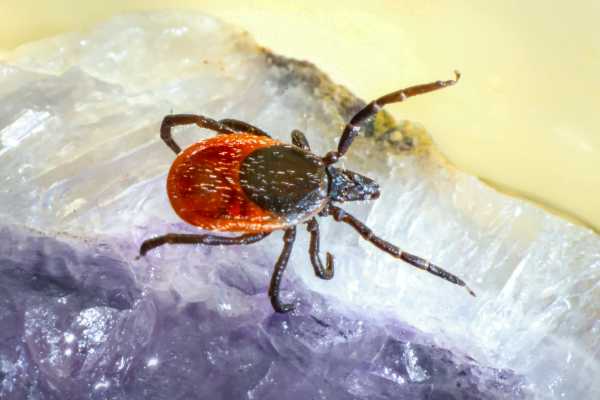Sarcoptic mange in dogs
How to Identify, Prevent and Treat
Sarcoptic mange in dogs - The health of our dogs is a priority for any guardian, and one of the most worrying problems that can affect dogs' skin is sarcoptic mange.
Also known as canine mange, this condition is caused by a microscopic parasite called Sarcoptes scabiei var. kennelsThis can cause extreme discomfort and, in severe cases, complications that can affect the dog's quality of life.
In this article, we will explore in detail what sarcoptic mange is, its symptoms, forms of treatment and prevention. The aim is to provide clear and practical information to help you protect your four-legged friend from this unpleasant condition.
Contents
What is Sarcoptic Mange?
Sarcoptic mange is a contagious skin disease caused by mites that pierce the dog's skin to lay their eggs. These parasites feed on skin cells and body fluids, which causes an intense inflammatory response.
It is a common condition in dogs, but it can also affect other animals and even humans, although the symptoms are less severe in humans.
The mite's life cycle is relatively short, but long enough to have a major impact on the animal's health. After the adult female lays her eggs on the dog's skin, they hatch within a few days, releasing larvae that quickly turn into adults, restarting the cycle. This continuous cycle of reproduction and infestation is what makes sarcoptic mange such a difficult condition to control.

Symptoms of Sarcoptic mange
The symptoms of sarcoptic mange are quite distinct and, unfortunately, extremely uncomfortable for the dog. The first sign is intense, uncontrollable itching, which causes the dog to scratch and bite itself incessantly. The itching is caused by the body's allergic reaction to the mite and its metabolic products.
Other symptoms include:
- Hair lossAs the dog continues to scratch, the hair begins to fall out, especially in areas such as the ears, elbows, abdomen and paws. The lesions begin to spread and worsen over time.
- Redness and inflammation of the skinThe dog's skin can become red, inflamed and sore due to constant itching. The affected areas may appear thick and scaly.
- Wounds and scabsLesions caused by intense itching can develop into open sores, which eventually form scabs. These scabs are prone to secondary infections, further aggravating the clinical picture.
- Changes in behaviorBecause of the extreme discomfort, the dog can become irritable, anxious or even depressed. Lack of sleep due to incessant itching can lead to fatigue and a noticeable change in the animal's behavior.
- Unpleasant smellAs secondary infections take hold, the affected areas may begin to emit an unpleasant odor.
How is Sarcoptic Mange Transmitted?
Sarcoptic mange is highly contagious and can be transmitted from dog to dog by direct contact. This means that the simple fact of your dog interacting with an infected animal can be enough for transmission to occur. Contamination can also occur through shared objects, such as beds, toys or even the surface where the infected dog has been.
Although it is less common, humans who have direct contact with infected dogs can develop a mild and temporary form of mange, which usually manifests itself as a rash.
Diagnosis of Sarcoptic mange
The diagnosis of sarcoptic mange is based on a combination of clinical signs and laboratory tests. Due to the similarity of the symptoms to other skin conditions, such as allergies or other forms of dermatitis, it is essential that the diagnosis is made by a veterinarian.
The most common test is a skin scraping, where a sample of the dog's skin is taken and examined under a microscope to check for the presence of mites or their eggs.
However, in some cases, the mites may be so few in number that they are not easily detected, which can make diagnosis difficult. In these cases, the vet may opt for a diagnosis based on the response to treatment, where the dog is treated for sarcoptic mange and the improvement in symptoms confirms the condition.

Sarcoptic mange treatment
The treatment of sarcoptic mange is focused on eliminating the mites and relieving the uncomfortable symptoms. There are several treatment options available, and the ideal plan can vary depending on the severity of the infestation and the dog's general health.
1. topical medicinesOne of the most common forms of treatment is the application of topical medication, such as medicated creams or shampoos, which kill the mites and relieve skin irritation. These products should be used as indicated by the vet, and treatment is usually continuous until all the mites have been eliminated.
2. Systemic MedicinesIn more serious cases, the vet may prescribe systemic medication, such as tablets or injections that eliminate the mites from the inside out. These drugs are effective, but it is important to strictly follow the vet's instructions to avoid side effects.
3. Environmental controlIn addition to treating the dog, it is crucial to control the environment in which it lives. This includes washing bedding, toys and anything else that could be contaminated with mites. In some cases, the vet may recommend using specific products to disinfect the house.
4. Treatment of Secondary InfectionsIf the dog has developed secondary infections due to the skin lesions, the vet may prescribe antibiotics or antifungals to treat these infections.
Prevention of Sarcoptic mange
Prevention is always the best strategy when it comes to animal health. Although it is difficult to completely prevent sarcoptic mange, especially if the dog interacts with other animals, some measures can reduce the risk of infestation:
1. avoid contact with infected animalsIf you know that a dog is infected with sarcoptic mange, prevent your dog from coming into contact with it until treatment is complete.
2. Maintaining hygiene: Maintaining good hygiene in your dog's environment is essential. This includes regularly washing bedding, toys and any other items that the dog uses frequently.
3. Regular visits to the vetKeeping regular appointments with the vet helps to identify and treat any health problems before they become serious.
4. Use of preventive productsSome topical or systemic products, such as anti-parasite collars or oral medication, can help prevent infestations of mites and other parasites. Consult your vet to find out which product is best suited to your dog.
Sarcoptic mange in humans: a real risk?
Although sarcoptic mange is primarily a canine condition, it can affect humans, especially those who have direct contact with infected dogs. In humans, the infestation usually results in a mild and temporary dermatitis, characterized by itching and rashes, especially in areas that have had contact with the dog. Fortunately, treatment is simple and the condition does not spread from person to person as it does among dogs.
Conclusion
Sarcoptic mange in dogs is a condition that can cause great discomfort for both the animal and its owner. However, with early diagnosis and appropriate treatment, most dogs recover completely. The key to avoiding this condition is prevention, which involves keeping the environment hygienic, avoiding contact with infected animals and making regular visits to the vet.
If you suspect that your dog may have sarcoptic mange, it's important to seek veterinary help immediately. Remember that the sooner treatment is started, the less suffering your four-legged friend will have to endure.
Thank you for visiting us and check out our other work
https://vettopbr.com/cachorros/







